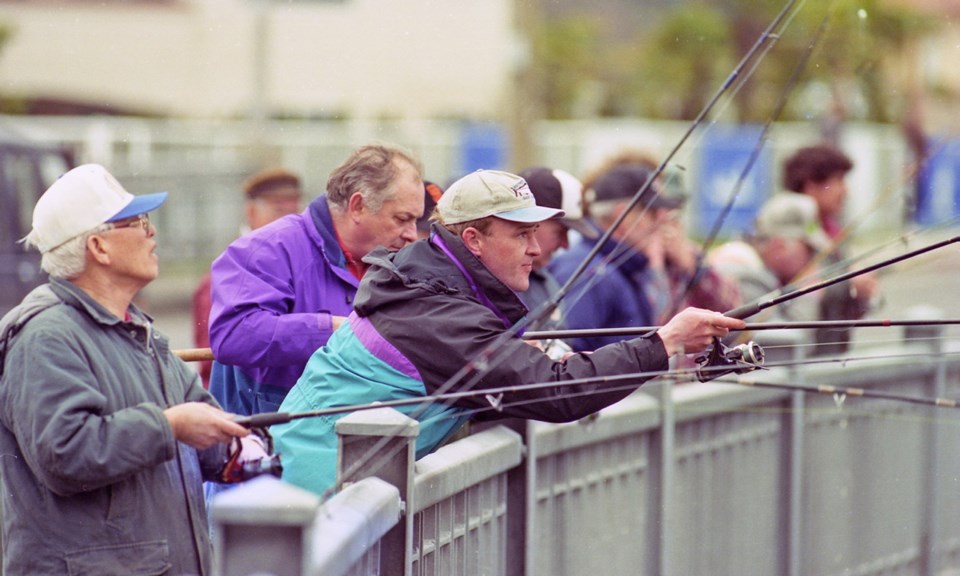 “There’s one,” John George says, and starts reeling. He must be a patient man. He has been jigging from the Craigflower Bridge since 11 a.m. — four hours — and this is only the second herring he’s caught. It flashes silver as he drops it in a bucket.
“There’s one,” John George says, and starts reeling. He must be a patient man. He has been jigging from the Craigflower Bridge since 11 a.m. — four hours — and this is only the second herring he’s caught. It flashes silver as he drops it in a bucket.
George must like his own company, too. Herring fishermen used to stand shoulder to shoulder on the bridge each spring, but today he’s the only one.
Now 65, he has been doing this since he was six, seven years old. He used to be able to fish all the way down to the rapids, even to the Selkirk Water, but the bridge is the only place now, and even then it’s slim pickings.
“It’s hit and miss, eh? You have to work at it,” he says.
It has, in fact, been hit and miss for a generation. Millennials have never seen the great masses of herring that used to flood into the Gorge early each year.
This season was particularly thin, Jacques Sirois says. “It seems we’ve reached the bottom of the barrel this year. It has been spectacularly low in numbers of herring.”
Sirois is chairman of the Friends of the Victoria Harbour Migratory Bird Sanctuary. If it seems odd that a bird guy is fretting about herring, remember that they’re all interconnected.
Herring, living near the bottom of the food chain, are key to the survival of everything above. They’re eaten by all manner of creatures — salmon, birds, groundfish, humpbacks — while other animals, notably chinook-eating orcas, depend on them indirectly. Herring might not be as iconic as killer whales, but they’re vital to the latter’s survival.
The loss of herring has coincided with the decline of coastal water birds, Sirois says. The Salish Sea’s population of glaucous-winged gulls is down 50 per cent since 1980 (the absence of the herring as a food source might contribute to the migration of gulls to the cities). Wintering western grebes once flocked here by the thousands to feast on the little fish. No more.
The Victoria area still sees periodic proliferations of herring, even signs of recovery, Sirois says. It’s why, in 2012, two dozen brown pelicans made themselves at home at Fisherman’s Wharf for three weeks. (“It felt like we were in San Diego for a while.”) Later, 150 Pacific white-sided dolphins came all the way inside the breakwater to feed.
But really, Sirois says, the last big Victoria-area spawn was in 2013 in the waters off the old Colwood gravel pit where the Royal Bay development is now rising. The last one in the Gorge was well before that.
Why the collapse of Pacific herring? Overfishing by the commercial roe herring fleet is the obvious answer, Sirois says. He was told that 50 years ago there were so many boats scooping up herring around Race Rocks that when lit up they looked like another suburb of Victoria.
It’s why he (and others) were dismayed when Fisheries and Oceans Canada allowed a commercial harvest off Hornby Island last month. “It’s ecological insanity.”
There’s also, ironically, the toll taken on herring by recovering species. Humpback whales are back, maybe 200 of them in the Salish Sea.
“They eat a lot of herring.” So do harbour seals, whose numbers have rebounded since bounty and sport hunters stopped shooting them in the 1970s. Ditto for sea lions, whose numbers also soared after we stopped culling them (including machine-gunning them from patrol boats at one point).
The good news for Canada’s oldest bird sanctuary, which has stretched from Ten Mile Point to Macaulay Point and all the way up the Gorge to Portage Inlet since 1923, is that despite low numbers of herring and other wildlife, the diversity of species there remains. “The biodiversity is still here,” Sirois says. “There’s still hope.”
In fact, all this gloom over herring runs counter to what Sirois calls a huge, under-the-radar success story: the billion-dollar-plus restoration of wild habitat around Greater Victoria.
Dozens of unrelated initiatives, from the Victoria sewage-treatment project, to reclamation of B.C. Hydro’s Rock Bay lands (“phase three alone was $150 million”), to the $25-million cleanup of contaminated soil at Laurel Point and the “rewilding” of shorelines have transformed the city in a good way.
“Victoria Harbour, the Gorge Waterway, Selkirk Water, all these waters haven’t been this clean in 50, 60, 70 years,” Sirois says. Our array of urban wildlife includes river otters, Pacific great blue heron, coho salmon, marbled murrelets, black oystercatchers, Olympia oysters. …
“It’s a very positive restoration story that’s still unfolding. It’s fantastic. It’s one of the best restoration stories in urban Canada.
“There’s a missing ingredient, though: the herring.”



